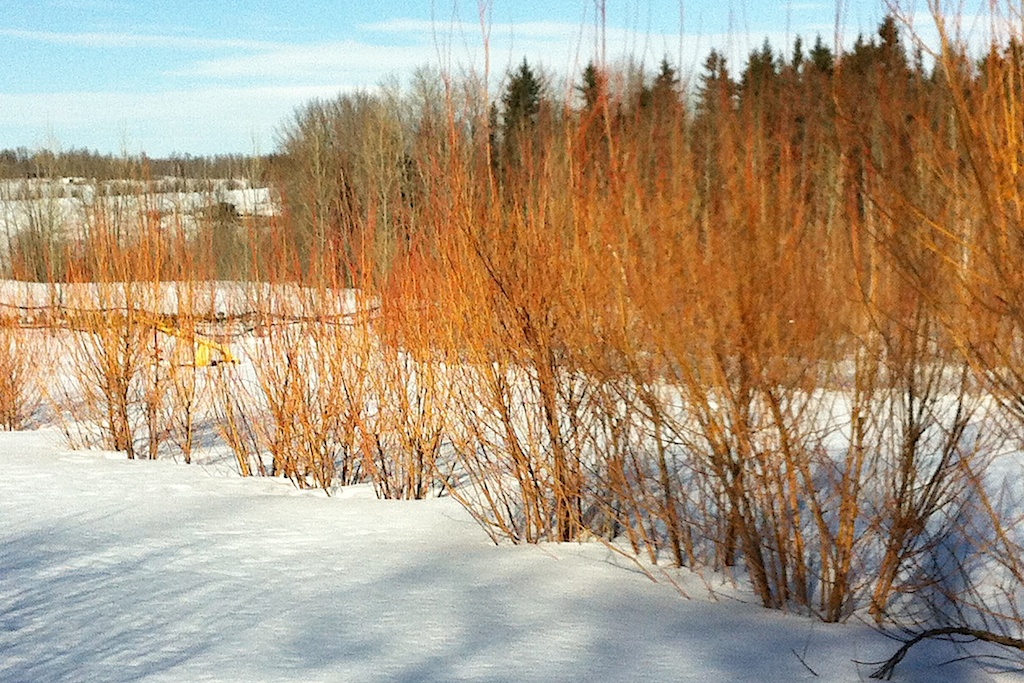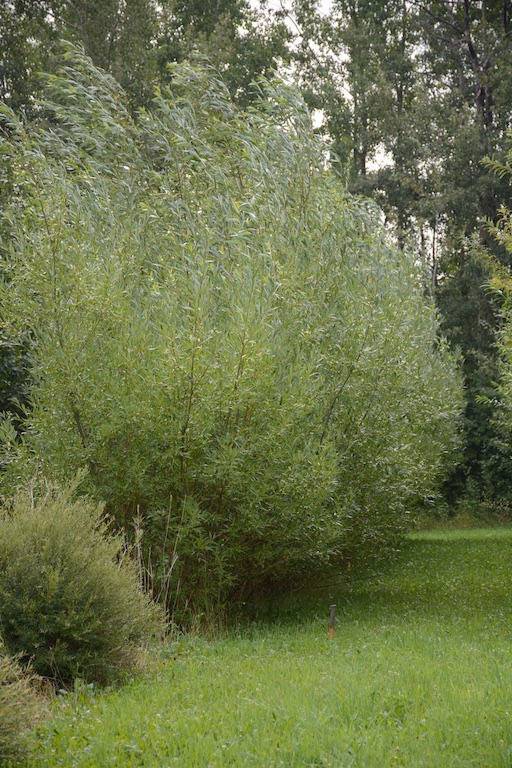
Row of lilacs and cotoneaster along my driveway.
Hedges
A hedge is a row of shrubs spaced close enough together that the individual shrubs merge together. If a windbreak is the Great Green Wall, then a hedge is the lesser green wall.
What are they good for?
Hedges are chosen for a variety of reasons:
- To mark an edge. This can be the edge of your property; a dividing line between play area and barbecue area; between formal landscaped area and informal, even wild, areas; between pretty areas and utilitarian areas; between public space and private space.
- To put a line or curve in the landscape.
- To provide privacy. (See also: Skinny Trees
- To hide portions of your place either to hide ugly, or to create a sense of mystery to pull you around the corner.

Cotoneaster can be clipped to make a formal hedge. Trim in mid June when the new growth is about 4-5 inches long. In late July you may need a lighter trip.
When I was a kid, we had a cotoneaster hedge between our property and the Moore's. It was a lot cheaper than a fence, and never had to be painted. We didn't shear it, but just lie it go wild.
One of my customers has planted a row of wild rose between the part of the backyard near the house, which is set up for entertaining, and the back 30 feet which is a kitchen garden. In addition to being a visual marker, the thorns discourage the kids from running off the edge of the grass and into the corn.
I have a mixed hedge of cotoneaster and lilacs along one side of the driveway. The house is invisible from the road and hidden for most of the driveway.
Size and use
Tall hedges are ones you look UP at. My cutoff for these are ones over 8-10 feet. These have the purpose of separation. You can't see the other side at all.
Medium hedges are ones you look AT. You can see beyond them, but you can't see much of the ground beyond them. You may be able to see through the top of them. Around 5-6 feet. These have a "stay on the path" message, but don't say, "keep out". These are also used as 'mystery hedges' to get you to wonder what is around the corner. and maybe put down your glass of wine and go.
Short hedges are ones you look OVER. There is only a narrow strip of ground on the other side that you can't see if you approach the hedge closely. These are marker hedges. Used to separate different yard functions. They are also used as lines to draw the eye.
Pruning
Hedges can be formal: Sheered flat into walls. Generally this works better with shrubs with smaller leaves. Some plants will develop smaller leaves as you trim them. More twigs, more buds, but the same overall leaf area. A formal hedge requires twice annual pruning at least, and sometimes more.
Hedges can be informal: You don’t try to keep them flat. You prune off ends to keep them bushy, and also take out dead wood.
Sometimes the pruning just isn’t sufficient, and you end up with a cloud of leaves 8 feet in the air with a bunch of bare branches below. Landscapers refer to ‘rejuvinating’ but it’s really a chainsaw haircut. Cut it off as low as you can in late fall or early spring, and wait for it to grow back. Because you have a full size root system it will usually get to about half it’s height in the first year. This works really well with willows, lilac, dogwood, and caragana.

Golden Willow gets up to 30 feet tall, but can be maintained at a lower height. If you want a smaller version, check out Flame Willow.

Common osier willow is another fast growing hedge that gets to about 12 feet tall.

Chokecherries feed the birds, and provide fall colour.

Skybound cedar about 3 feet tall.


Water them now and then. This is your reward in late spring.
Tall Hedges
Golden Willow If you let it this will get 30 feet tall. See the section below on rejuvenating. Cut it to any height you want. Plant on your side of the county road ditch to reduce dust and hide the house from the road. Golden willow is also a good nurse tree for anything that will tolerate light shade. Very fast growth. Prune hard to keep looking good.
Flame Willow A hybrid between golden and something else. (willows are shameless about hybridizing) Flame gets about 15 feet high x 6 feet across. Newest growth is red. As it ages it fades to orange then yellow, then the yellow bleaches out leaving grey. Whole process takes about 3 years. Colours are best in winter against the snow. Prune hard in spring to have nice colour for next winter.
Green Alder 10 to 15 feet tall. Prune hard in dormant season. Take out dead wood anytime. If you let it go it gets leggy. Shade tolerant. Rejuvenate. Good tree for bad soil. The wood has a nice flavour for smoking meat and fish.
Amur Maple 10-12 feet. Can be trained to tree form or hedge form. Bright red leaves in fall. New leaves are red when they first open too.
Skybound Cedar 10 to 18 feet x 3 to 4 feet. One of the best cedars for our climate. Good formal hedge. Plant 3 feet apart, and sheer twice a year.
Native Pussy Willow 12 feet x 5 feet. Early bud break, late fall leaf drop. Beautiful 3/4" fuzzy catkins in early spring. Prune hard yearly. Usually needs some supplemental water.
Common Osier Willow 10 feet x 6 feet. Can be pruned narrower.
Native Chokecherry 10 feet x 4 feet. Somewhat vase shaped, so mowing near the base is easy. Prune to make it get thicker. Nice green leaves, that turn pink and orange in the fall. Small black berries that can be used for jam, or left for the birds. Prune half the growth each year until it's 5 feet high to encourage bushiness. Check for Black Knot each autumn after leaf drop.
Native Pincherry Similar to chokecherry, but with smaller red berries. Not as susceptible to black knot fungus.
Native High Bush Cranberry 10 feet x 5 feet. Small white flowers in spring, dark green three-lobed leaves that turn bright red in fall. Edible berries that do taste much like cranberries, but sweeter.
Common Lilac and Late Lilac Both grow to 8-12 feet, but tend to get leggy at the upper end of the their height. Lovely scent. Prune hard right after blooming to keep them thick.
Caragana Very tough plant. 6-10 feet. Seeds tend to spread. Don't plant within 15 feet of another garden or an unmowable hill. It will take over. Good tree for crappy soil, it fixes it's own nitrogen. The wood is used for small crafts such as fancy pen barrels. The plant is rough and somewhat thorny, and has been known on occasion to consume pets and small children.
Sea Buckthorn 6-9 feet.Spiny monster with narrow silver leaves. If you want to keep the neighbors out, the is the closest thing to barb wire I've got. Orange berries on female plants are tart, with a lemony aftertaste, high in anti-oxidants. But I have no idea how they pick commercial quantities. If you plant a hedge of these, pick up a used biker jacket to work with them. The leaves can be used for herbal teas, I'm told.
Romance Cherries Dwarf cherries, about 7-8 feet tall. Produce sweet and sour cherries. I have 3 types. Hey, make the hedge earn it's keep.
Medium Hedges

Cotoneaster in fall. Birds love the berries.

Native shrub with silver-green folliage, and tiny yellow flowers in spring with a heavy floral scent. 4-8 feet tall, but somewhat leggy looking at full height. Prune hard every 2-3 years.
Hedge Cotoneaster 5-7 feet. One of the traditional hedges. Cotoneaster can be left uncut for an informal hedge, or pruned as a formal hedge. Flowers are inconspicuous, but has nice red and orange fall colour, and black berries that the birds will thank you for.
Dogwood About 5 feet high. Clusters of white flowers through summer, purple leaves in fall, Red twigs in winter. Spreads slowly by suckers from the base. Prune hard in spring to have lots of red twigs for the following winter. Control with mowing. Tolerates being browsed by deer. Bluish white berries that birds love.
Wolf Willow 4-6 feet tall. Native thicket forming silver leaved shrub. Tolerates some shade, and looks like it's glowing. Heavy scented tiny yellow flowers in spring. Prune hard.
Nanking Cherry Looks best when you prune it to about 4 feet tall. Produces bright red small cherries with wonderful flavour. Bit tart, but still good. Covered in white flowers in early spring. Berries are edible, but the Cree considered them starvation food.
Ninebark 4-6 feet. Diablo and Centre Glow. Both start with green foliage and get more and more purple as the summer progresses. Diable is almost black. Centre Glow during much of the season has dark edges with interior of leaves shading from light green to red to medium purple. Amber Jubilee is a mix of green, yellow, orange, and purple most of the summer
Hansa Roses Also called floribunda roses. Most common colour is a deep pink. Flowers more or less continually all summer. Rejuvinate with a chainsaw haircut when it gets leggy looking.
Low Shrubs
Blueberries Come in various heights, but mine get about 4 feet tall. Blueberries are a bit fussy on the prairie, and you may want to grow them in a raised bed. They also need frequent light watering. Probably best if you can put them on a timer.
Raspberries Another edible shrub. Not terribly opaque when trellised for convenient picking, but can make a good edge to the yard, or garden. Works well as a foundation plant against a fence.
Currants About 3 to 4 feet high. Can get better height, and narrower width by supporting with a peony ring. This also makes them more convenient to pick.
Canada Buffaloberry Dark green small leaved shrub, about 3-4 feet tall.
Silver Buffaloberry Silvery oval leaves. Orange to red berries in fall. Bird food, not people food.
Snowberry 2-3 foot high shrub with dark green thumb sized leaves. In fall the leaves fall apart leaving delicate traceries of veins. Large pea to small marble sized white berries.
Wild Rose 2-4 feet tall. Prune lightly to make bushy. Green in summer, lots of pink flowers in early summer, red hips (seed pods) in winter. Red and orange fall colour.
Got something to say? Email me: sfinfo@sherwoods-forests.com
Interesting? Share this page.
Want to talk right now? Call me: (8 am to 8 pm only, please) 1-780-848-2548
Do not arrive unannounced. Phone for an appointment. Why? See Contact & Hours That same page gives our hours of operation.
Back to Top
Copyright © 2008 - 2021 S. G. Botsford
Sherwood's Forests is located about 75 km southwest of Edmonton, Alberta. Please refer to the map on our Contact page for directions.
